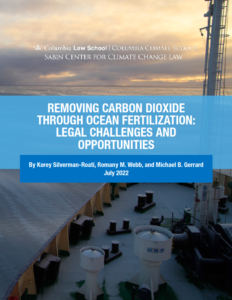By Korey Silverman-Roati
Carbon dioxide removal (CDR) will be needed, alongside deep emissions cuts, to achieve global temperature goals. The Intergovernmental Panel on Climate Change (IPCC) has emphasized that, to limit warming to 1.5oC or 2oc, in line with the Paris Agreement, global carbon dioxide emissions must reach  net-zero between 2050 and the early 2070s. According the IPCC, achieving net-zero emissions will require deployment of CDR “to counterbalance hard-to-abate residual emissions” from “agriculture, aviation, shipping, [and] industrial processes.” Scientists have proposed a number of land- and ocean-based CDR techniques. Interest is growing in ocean-based techniques, including ocean fertilization. A 2022 report by the National Academies of Sciences, Engineering, and Medicine (NASEM) recommended a $440 million investment in ocean fertilization research, including in-ocean field trials, to evaluate its CDR potential and risks.
net-zero between 2050 and the early 2070s. According the IPCC, achieving net-zero emissions will require deployment of CDR “to counterbalance hard-to-abate residual emissions” from “agriculture, aviation, shipping, [and] industrial processes.” Scientists have proposed a number of land- and ocean-based CDR techniques. Interest is growing in ocean-based techniques, including ocean fertilization. A 2022 report by the National Academies of Sciences, Engineering, and Medicine (NASEM) recommended a $440 million investment in ocean fertilization research, including in-ocean field trials, to evaluate its CDR potential and risks.
The Sabin Center today released a white paper exploring the legal framework for ocean fertilization research and deployment, both at the international and domestic (U.S.) levels. This is the fourth in a series of four white papers exploring the legal issues associated with various ocean-based CDR strategies, including ocean alkalinity enhancement, artificial upwelling and downwelling, and seaweed cultivation. Together, these white papers provide the most comprehensive analysis yet of legal issues associated with ocean CDR.
Ocean fertilization involves adding iron or other nutrients to the ocean to stimulate the growth of phytoplankton that uptake carbon dioxide and convert it into organic carbon. To work as a carbon sequestration technique, the organic carbon will need to end up sequestered in the deep ocean when the phytoplankton die and sink.
Scientists have conducted a number of in-ocean fertilization experiments, which suggest that adding iron does stimulate phytoplankton blooms, leading to increased uptake of carbon dioxide. However, further study is needed to evaluate whether ocean fertilization leads to long-term carbon storage and evaluate its potential co-benefits and risks, including the potential for nutrient-diversion from other ocean areas.
The 2022 NASEM report noted that ocean fertilization appears to have “ relatively high scalability and low costs for deployment” but cautioned that, because of these low costs, the strategy is “prone to misbehavior by individuals or small organizations or companies.” Establishing a robust legal framework is essential to avoid this outcome. The 2022 NASEM report emphasized the need for research into the existing legal framework for ocean fertilization, both internationally and domestically in the U.S., to determine whether it is fit for purpose.
The Sabin Center’s white paper provides the first comprehensive analysis of when and how existing international and domestic (U.S.) law will apply to ocean fertilization projects. As explained in the paper, there are currently no legally binding international treaties dealing specifically with ocean fertilization. However, in recent years, three international treaty bodies (the London Convention, the London Protocol, and the Convention on Biological Diversity) have taken initial steps to develop rules for ocean fertilization research and deployment. Most notably, the parties to the London Protocol have adopted an amendment which, if and when it enters into force, will create a specific permitting regime for ocean fertilization projects. To date, however, only six of the fifty-three parties to the London Protocol have ratified the amendment and it is yet to enter into force. Nevertheless, ocean fertilization projects may be subject to permitting or similar requirements under other international agreements, which establish general rules for ocean-based activities. There is some uncertainty as to when and how those general rules will apply to ocean fertilization projects.
At the domestic level in the U.S., the Marine Protection, Research, and Sanctuaries Act (MPRSA) regulates the discharge of material into ocean waters within twelve nautical miles of the U.S. coast and further offshore in some cases. Ocean fertilization projects are likely to require a permit from the U.S. Environmental Protection Agency under the MPRSA. Additional permitting and other legal requirements could apply to the mining and processing of iron and other materials for use in ocean fertilization. Projects may also be subject to environmental review requirements under U.S. federal and state law.
The paper released today includes detailed analysis of the application of the above international and U.S. laws to ocean fertilization research and deployment.
Read the full paper here.
Related work: The Sabin Center has prepared a series of white papers examining legal issues associated with carbon dioxide removal and storage. Previous papers have discussed the legal framework for carbon removal via seaweed cultivation in California, seaweed cultivation under international and U.S. federal and state law, artificial upwelling and downwelling, ocean alkalinity enhancement, enhanced weathering, as well as carbon storage in the sub-seabed off the east and west coasts of the United State and the west coast of Canada. For more information about this and other related work, visit our website here.
Korey is a Climate Law Fellow at the Sabin Center for Climate Change Law






